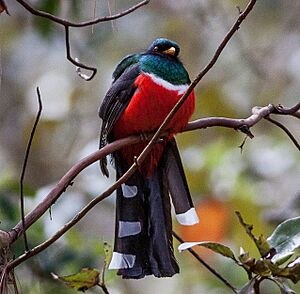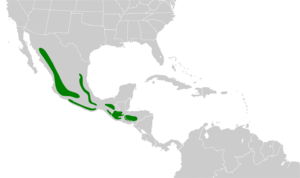Mexican trogon facts for kids
Quick facts for kids Mexican trogon |
|
|---|---|
 |
|
| Male | |
| Conservation status | |
| Scientific classification | |
| Genus: |
Trogon
|
| Species: |
mexicanus
|
 |
|
| Synonyms | |
|
Trogon glocitans Lichtenstein, 1830 |
|
The mountain trogon (Trogon mexicanus) is a colorful bird found in the forests of Central America. It is also known as the Mexican trogon. This bird was first described by a scientist named William Swainson in 1827.
Mountain trogons live mainly in Guatemala, Honduras, and Mexico. Sometimes, they are seen in El Salvador as well. Like all trogons, the male and female look different. The male is bright green with a red belly. The female is mostly brown with a red belly.
These birds live in moist mountain forests. They especially like forests with pine and oak trees. They can be found at high elevations, from about 3,000 to 10,000 feet (900 to 3,000 meters) above sea level. Mountain trogons can even live in coffee farms if there are enough shade trees.
Contents
About Its Name and Family
Scientists use a system called taxonomy to name and group living things. The mountain trogon's scientific name, Trogon mexicanus, was given by William Swainson in 1827. He found the first bird specimen in Temascáltepec, Mexico.
Over time, other scientists also described this bird. But most agree with Swainson's original name. The mountain trogon has three different types, called subspecies:
- T. m. clarus was described in 1932.
- T. m. lutescens was also described in 1932.
- T. m. mexicanus was the first one described in 1827.
Scientists have studied the DNA of trogons to understand how they are related. These studies show that the mountain trogon belongs to a group of "Elegant" trogons. This group includes birds like the elegant trogon and the collared trogon.
The name Trogon comes from a Greek word meaning "gnawing" or "nibbling". This might be because trogons use their beaks to chew holes in rotting trees to make their nests. The second part of the name, mexicanus, simply means "from Mexico". This is where the first mountain trogon was found.
What Does It Look Like?
The mountain trogon is about 11.5 to 12.5 inches (29 to 31.5 centimeters) long. It usually weighs between 2.2 and 3 ounces (61.5 to 85 grams).
The adult male is very colorful. His head, neck, and upper body are a shiny green. The top of his tail is bluish-green with black tips. His face and throat are blackish, and he has a bright yellow bill. Around his eye, there is an orange-red ring. His chest is green, and his belly and under-tail are bright red. A thin white stripe separates the green chest from the red belly. The underside of his tail is black with three large white patches.
The female mountain trogon is less colorful than the male. Her head and upper body are a warm brown. The top of her tail is reddish-brown with black tips. She has a small white mark in front of her eye and a clear white mark behind it. Her bill is dark on top. Her chest is warm brown, and her lower chest is a lighter brown. A thin white stripe separates her chest from her red belly. The underside of her tail is black and white.
Spotting the Difference
It can be tricky to tell the mountain trogon apart from other similar birds. The main differences are in their tails. For example, the male elegant trogon has a copper-colored tail on top, not green. Its tail is also finely striped black and white underneath. The female elegant trogon has a white patch behind and below her eye.
The male collared trogon has a golden-green back and upper tail. Its under-tail is black with thin white stripes. The female collared trogon has a grayish tail underneath with a thin dark bar at the tip of each feather.
Where Do They Live?
The mountain trogon lives in the high mountain areas of Mexico, Guatemala, and Honduras. It used to be found in El Salvador, but that area became part of Honduras in 1992. Now, it only visits El Salvador sometimes. They are also seen in Nicaragua, but it's not clear where those birds come from.
These birds live at elevations from about 3,000 to 10,000 feet (900 to 3,000 meters). They prefer forests with pine trees or a mix of pine and oak trees. They also live in cloud forests, which are forests often covered in clouds.
Behavior
Mountain trogons sometimes join groups of different bird species. When they do, they are active members of the group. They move around in the middle and upper parts of the forest canopy.
Food and Feeding
Mountain trogons eat insects and small fruits. They catch insects or pick fruits while they are flying.
Reproduction
Like all trogons, the mountain trogon builds its nest in a hole or cavity. They can make their own nest holes or use holes made by other animals.
When they make their own nest, they use their strong beaks to chew a hole in soft, rotting wood. This can be in a decaying tree stump or a branch. The nest hole is usually less than 4 feet (1.2 meters) off the ground. But sometimes, it can be as high as 12 feet (3.7 meters). If they use a hole made by another animal, it's usually one made by a large woodpecker.
The female mountain trogon lays two white eggs. Both parents help to keep the eggs warm, but the female spends much more time on the nest than the male. The eggs hatch after about 19 days.
Voice
Mountain trogons make several different sounds. If they are worried, they make a sharp, low sound like "cut" or "tuck". When they are flying, they make a quick, low sound like "cut-a-cut-cut". When they are sitting on a branch, they make a slow, repeated "cowh" or "tucka-tucka-tucka". Young mountain trogons make quiet hissing sounds when they want food or when a possible predator comes near.
Conservation and Threats
The mountain trogon is considered a species of least concern by the International Union for Conservation of Nature. This means it is not currently at high risk of disappearing. This is because it lives in a large area, and its population is quite big. Scientists estimate there are between 50,000 and 499,999 mountain trogons. Their numbers seem to be stable.



